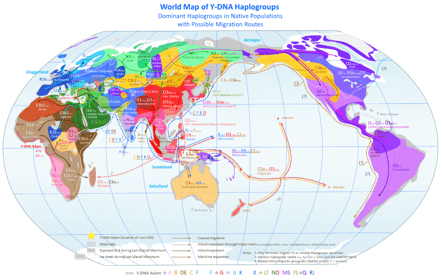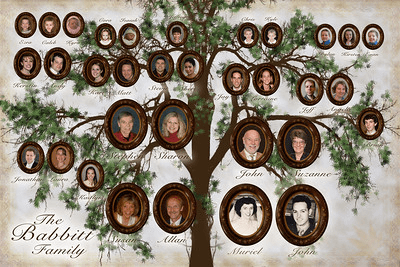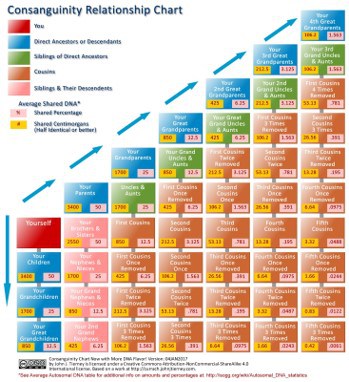Table of contents
Simply put, a DNA match is an individual that shares some portions of their genetic composition with you. DNA companies use member matching to identify other members from their database that are related to you.
To go further, they compare your DNA sample with that of every person in their database and estimate how closely you are related. Depending on several factors that we will be discussing here, they can match DNA and establish if you are siblings, first cousins, distant cousins, or not related at all.
Not related at all? So, does this mean that you can share DNA and not be related? Shortly, yes. We must factor in other information to find relatives in a process that will take time and may sometimes lead to dead ends.
But let us first discuss what a DNA match is and how it works.
How does DNA match work?
DNA is inherited by getting half of your genetic information from your mother and the other half from your father. But your genetic information does not tell us what portions you inherited from each. The first step for DNA matching is phasing. This process uses raw DNA data to distinguish between the two pieces of a person’s genome inherited from each parent.
Let’s say a section of your raw data is as follows:
A/C A/T C/G G/C A/A G/G A/A C/A T/A T/T C/C A/C A/T
The phasing process determines what portions you inherited from your mother and your father:
Mother: A A C G A G A C T T C A A
Father: C T G C A G A A A T C C T
The next step is to try to find people who have matching DNA portions. For example, let’s say that we find another individual that has the following genetic composition:
A T T A C G G A T T C A G
A C G C A G A A A T C G G
Note how the bolded portion of both strands is actually identical. This, however, does not mean that you and this individual are related. More thorough testing is required to determine if matching DNA between two individuals was inherited from the same relative. The results will then reveal if they are related or not.
Once an individual sharing your DNA is found, the genetic testing company will determine how much genetic information is shared. This information is used to establish how close a match they are. The more DNA you share, the greater the chances of you being related.

Why is DNA matching effective?
The concept is simple, but the process is certainly not. All of us inherited DNA from our parents, who inherited from their parents, and so on. A person’s DNA is made up of the genetic material of their ancestors. If you share an ancestor with another person, chances are you inherited portions of the same DNA.
But remember that we inherit millions of base pairs, and trying to find matches in all of them is a lot of work and tends to be expensive. To save time and money, companies analyze only the unordered pairs of nucleotides at only small portions of the entire genome.
Nevertheless, the matching process is highly effective and reliable at finding how much DNA you share with a person and if you are a relative or not.
DNA cousin matches and family history discovery
Finding close family members and ancestors is often the most exciting part of DNA testing. Millions of people around the world are motivated to take a DNA test by the prospect of discovering unknown relatives from their past. In fact, it has become a large part of genetic genealogy and family history. Another term for DNA matches is cousin matches, and you will see why throughout this article.
When you get test results from your DNA testing company, one of the most exciting parts is the list of matches found across their database. The next step now is to find out which of these matches are, in fact, related to you and have a common ancestor.
The next steps of a recent DNA match
This is where the matching process ends. Once again, the pure results of DNA matches do not guarantee kinship. Likewise, not being a genetic match with a cousin does not mean that you do not have a common ancestor.
What comes after understanding how matches are determined is the start of a journey of new discoveries about your family’s history. Here are some ideas on what you can do to get the most out of your DNA match.
Search for common ancestors
Once you have your matches, one of the first things you can do is find out if you have common ancestors with them. This will provide clues about how you both are related to each other.
You can estimate how long ago your shared ancestor lived through the degree of your and your matches’ relationship. How closely related you are to a match is determined by how much DNA you share with them.
It is also a good idea to see which ethnicities you might share with your match to help find a distant common ancestor.
Many DNA databases identify birth locations and surnames that are in both your tree and your match. Look out for this DNA match chart to find clues on where your shared ancestor lived.
Some tests such as Y-DNA (Y chromosome) or mitochondrial DNA (mtDNA tests) help trace either your paternal line or maternal line respectively through general haplogroups. These groups are genetic populations of people who share a common ancestor. Most DNA tests will also include ethnicity estimates and can tell whether your ancestors lived primarily in Africa, the British Isles, or nearly anywhere else in the world.

Family trees can also help by giving you insights on the lineage to look for your shared ancestor. It may happen that your match’s tree is not public. In most cases, the matching website will allow you to message them. If it is public, go through it to find clues; you will probably even find information or relatives you didn’t know about.
Use features in your DNA company
If you decide to use an ancestry test such as Ancestry or FamilyTreeDNA, use all the search features you can. You can search for specific surnames or locations.
How accurate is Ancestry DNA matches? Ancestry DNA matches and FamilyTreeDNA matches are some of the most useful and accurate in the world because of their large databases.
Get in touch with relatives
It is exciting to find new relatives you don’t know existed. Your DNA matches is a list of relatives that you can get in touch with. You can even work together to find records, stories, and any helpful information.
Be persistent
Not being able to find much information about your common ancestor is no reason to be discouraged. Every time somebody tests themselves, their data is entered into ancestry databases, which can be accessed, depending on the user’s chosen privacy settings.
Finding DNA match ancestors through lineage
Maybe you are not trying to find close relatives but instead, want to trace a line that will take you to a particular line of lineage. You are trying to find DNA matches that share a target shared ancestor.
This usually requires some deeper investigation, but most reputable companies will have the tools you need, so make sure you can find them.
Ideally, if you find known relatives from this ancestor, it is helpful to have them take a DNA test. This way, you can compare if DNA matches sharing those segments as these relatives descend from this ancestor.
If you get enough descendants from that ancestor tested, you could even identify a segment of your DNA that you possibly inherited from that ancestor. If you were to find this unique segment in one of your matches, you could tell right away that you and them share this ancestor.
Keep going back to your company’s website for updates. Test the rate at which this happens to have a good idea of how often you should visit.
What is a strong DNA match?
In 2018, more than 26 million Americans had taken an at-home DNA kit. Although the projections for this year were not necessarily met for several reasons, there is still a high volume of people getting themselves tested for ancestry reasons.
This availability increases the number of possible matches a particular service may provide for you. The problem is that your company might find thousands of matches! So, how do you know which ones to focus on?
The answer will depend on what you are looking for. Let’s take a look at how this works.
You received 50% of your DNA from each one of your parents and with your children. You share 25% with your grandparents and grandchildren and 12.5% with your great grandparents, uncles, aunts, nieces, and nephews. Identical twins share 100% of their DNA while fraternal twins share 50% of their DNA, the same as any other sibling.
The amount of shared DNA drops as you move further away from close relatives. For instance, you share around 3% with a second cousin (child of your great uncle and great aunt), which is still helpful to your genealogical result.
Once you identify a strong match, it is time to determine if they are relatives or not. Here are some steps you can take:
Check the family tree
If your match has provided a family tree, this is significant and invaluable. You may have better chances of success with a 0.5% match with an extensive family tree than with a 3% match that only has three or four members in their tree.

Check the DNA percentage chart
Some services provide a DNA match chart that shows the percentage of DNA you share with your match. The more DNA you share with a match, the more recent your common ancestor was.
The figures that indicate how close you are to a match are measured in centimorgans (cM), which are units that express the genetic links between two individuals. A strong match shares around 200 cM or more with you, which would be around 3% of your DNA.
Check the length of shared DNA segments
Not only is the amount of segments that you share with your match that may determine if you are related or not, but also which DNA segments you share. If the segments shared are long, this means that your common ancestor was probably more recent.
Let’s say that you have two matches sharing 6.25% of your DNA. One of them shares several small segments with you, while the other shares a few longer ones. This latter one is a stronger match.
The first case may indicate that you share several distant relationships, whereas the second shows a closer ancestor.
Your DNA company will usually list the number of shared segments and the size of larger segments. Place the ones with the largest common segments at the top and begin your research from there.
DNA match centimorgans
When people get their DNA results and ancestry information on all their matches, one confusing aspect is that of centimorgans. To make sense of your DNA results, you must know what centimorgans are and how they are measured.
What is a centimorgan?
Not to be confused with centimeters, centimorgan is a unit geneticists use to measure a DNA segment’s length. Typically, a person has around 6800 cMs, half from each parent. Although this number is not a ballpark figure, it is a rough approximation. This is because the distance that corresponds to a centimorgan varies within the different positions in the chromosome.
Also, you should note that the variations obey the fact that different companies examine different sections of the chromosome. From this number, you can better understand how many centimorgans do first cousins share, for instance.
Making sense of a centimorgan chart
The number of shared centimorgans with your match can help us better determine how you are related. The following DNA relationship chart provides an approximation of the number of centigrams shared by different members of your family. It can prove helpful in connecting possible relatives and common ancestors.

In 2015, Blaine Bettinger, a professional genealogist, started the Shared cM Project (ScP). This project is a collaborative data collection and analysis project created to understand the ranges of shared cM associated with various known relationships. The last update was March 2020.
Nebula Genomics and DNA matching
Nebula Genomics is a benchmark in genetic testing. Our 30x Whole Genome Sequencing guarantees that your family history -encoded within your genes- will be thoroughly analyzed. Whole genome sequencing will decode 100% of the human genome, ensuring you get the most information for your money. Autosomal DNA, in addition to Y-DNA and mtDNA is covered. Plus, we minimize errors by decoding each sequence 30-100x. These results are reliable and will help you get optimal DNA match results.
We have also partnered with FamilyTreeDNA to offer you the ultimate DNA testing experience combined with the world’s largest ancestry database. You are sure to find the maximum number of matches, which increases your chances of finding previously unknown relatives and ancestors you might want to learn more about.
Curious about what type of tests can help you start your family tree? Take a look at our brief overview of the types of DNA tests available.
If you would like to know more about some big DNA matching companies, you can also check out GEDmatch, DNA Painter, MyHeritage, Ancestry, and DNA Land.
Edited by Christina Swords, PhD.
